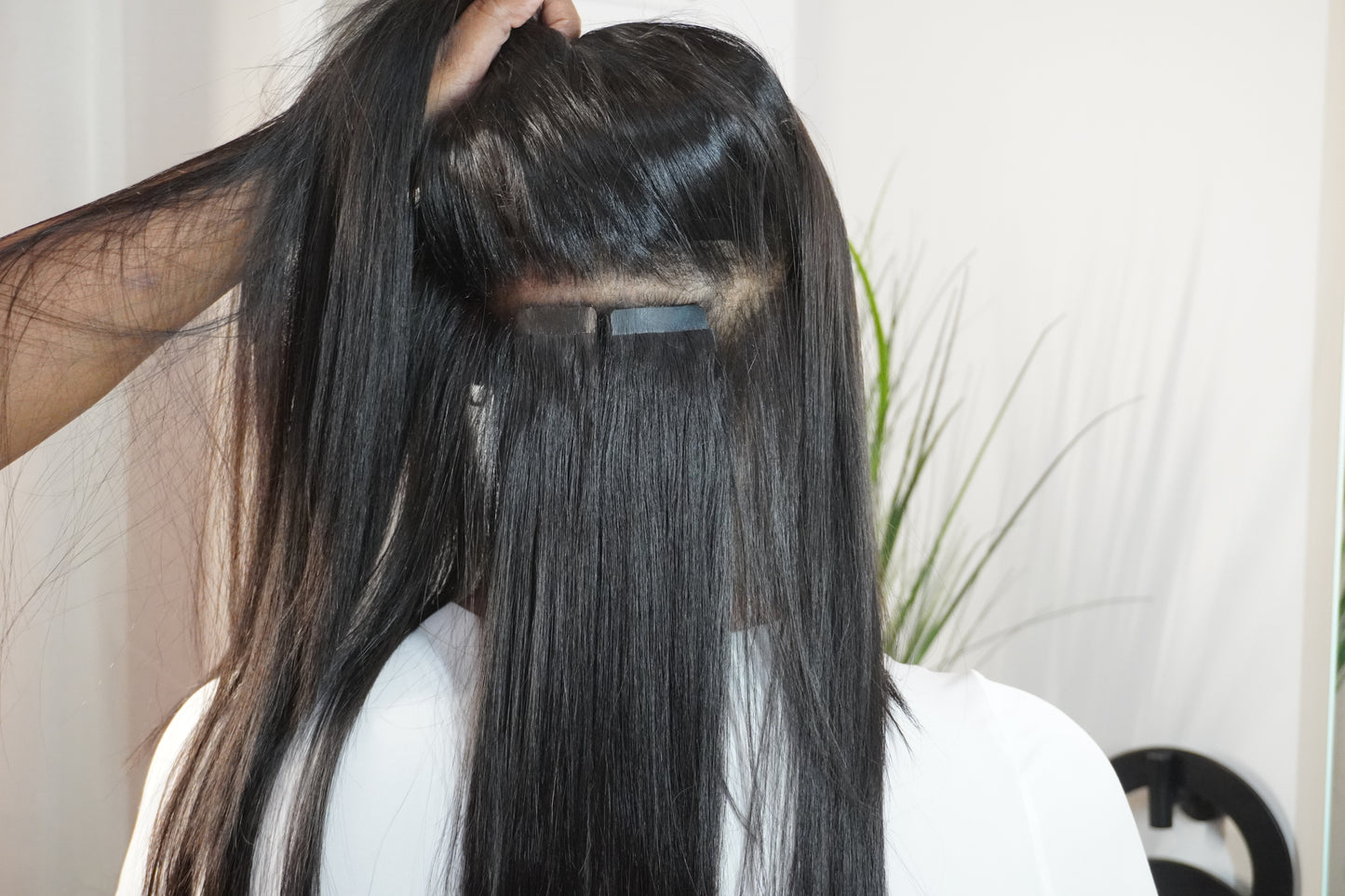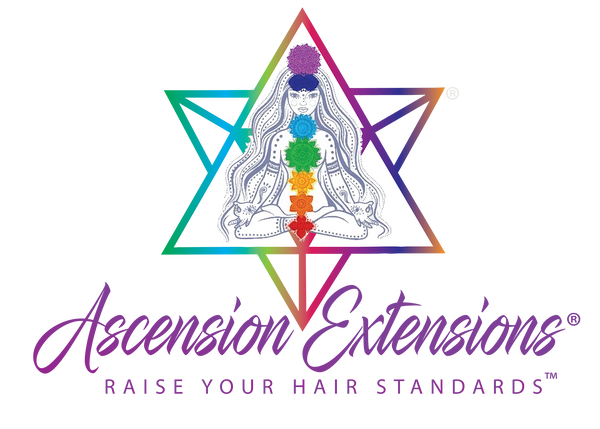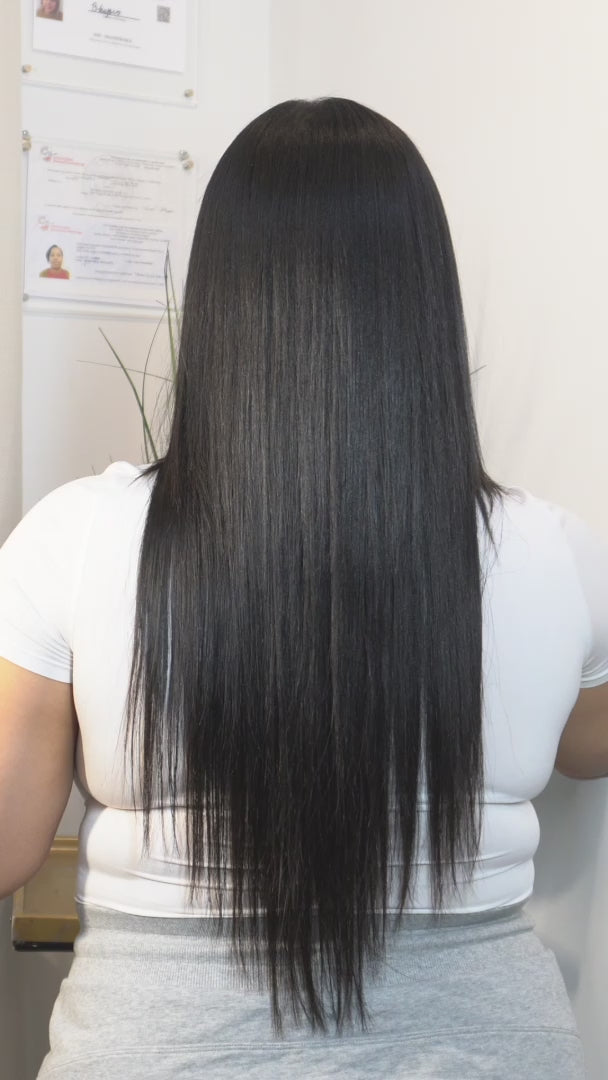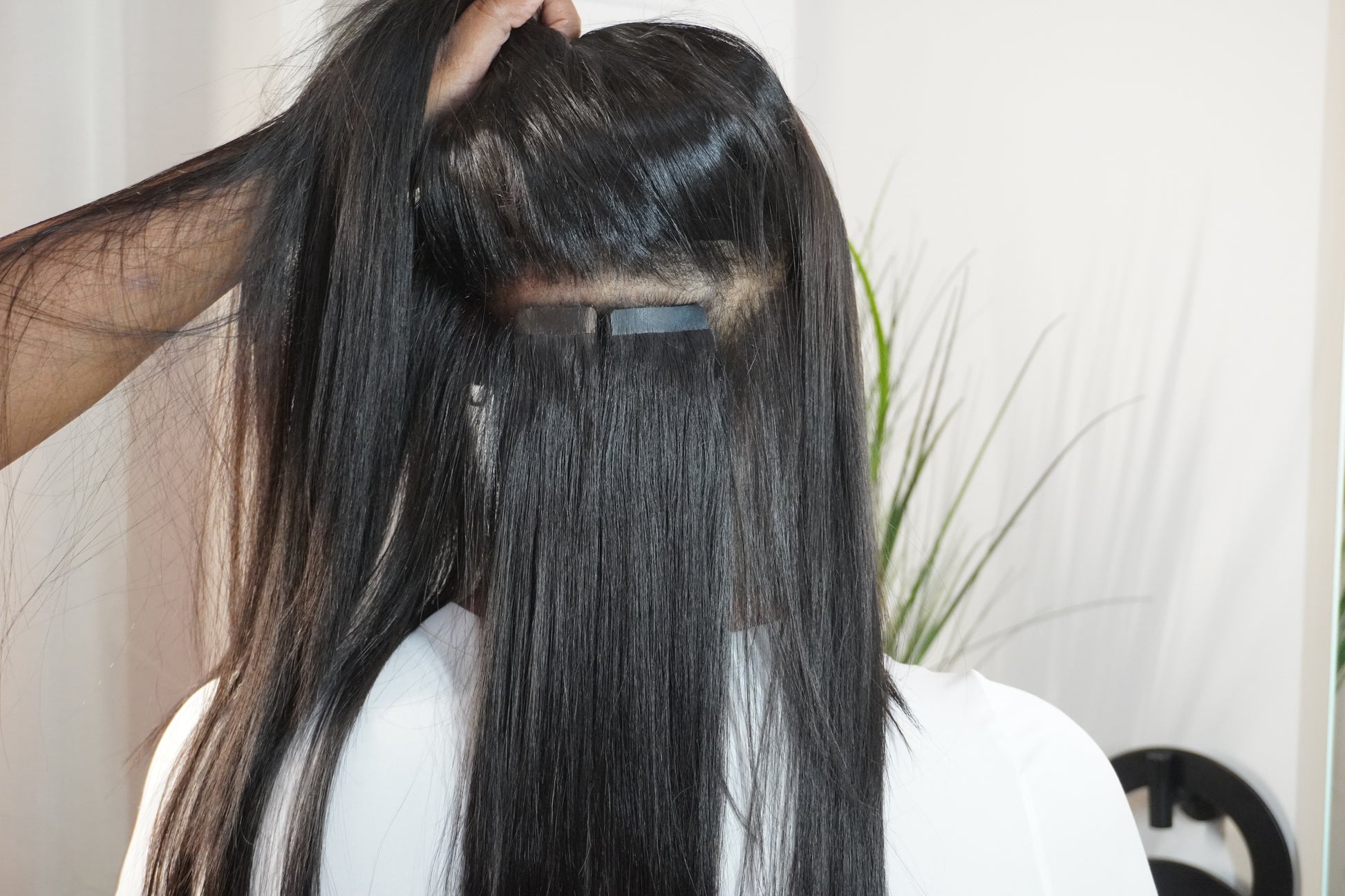Ascension Extensions
Asian Collection TAPE-INS
Asian Collection TAPE-INS
Couldn't load pickup availability
Tape-in hair extensions are a type of hair extension that uses thin tape wefts, which are typically 1 to 1.5 inches wide, that get "taped-in" in between your own hair in "sandwich" like bonds. This method is 100% natural, requires no tools or chemicals. Here's a bit more detail about them:
Installation
The installation process involves taking a section of your own hair and applying one tape-in hair extension above it and one below it, creating a sandwich. The adhesive tape on the extension is usually a medical-grade adhesive that is safe for skin and hair. Ascension Extensions tape-in come in 20pcs (50 grams) per pack, finer hair would typically need 1-2 packs and thicker hair would need 3-5 packs. (Consult with your Stylist for recommendations, number of packs needed will vary.)
Appearance and Maintenance
Tape-in extensions blend seamlessly with your natural hair, giving a natural and voluminous look. They require maintenance every 4-6 weeks, depending on hair growth and care, where the extensions are removed and re-applied closer to the scalp. Proper care includes using specific shampoos and conditioners that don't interfere with the adhesive, as well as avoiding oils and silicone-based products near the tape.
Benefits
- Quick and easy to apply: Much faster than sew-in, micro-link, and fusion extensions.
- Reusable: With proper care, tape-in extensions can be reused multiple times.
- Less damaging: They are lightweight and do not pull on your hair like other extensions, reducing the risk of hair damage.
- Seamless: They lay flat against your head, making them virtually undetectable.
Drawbacks
- Adhesive can weaken: If not properly maintained, the adhesive can weaken, causing the extensions to slip.
- Limited styling: High heat and certain oils or hair products can cause the tape to slip or degrade.
- Hair damage: If not applied or removed correctly, they can cause damage to your natural hair.
Tape-in extensions are a popular choice for those looking to add length and volume to their hair without the commitment or damage associated with other types of hair extensions. It's important to have tape-in extensions applied by a professional stylist to ensure they are placed correctly, look natural, and do not damage your hair. Proper aftercare is also crucial to maintain the health of your natural hair and the longevity of the extensions. Tape-in extensions offer a balance between durability, ease of application, and a natural look, making them a popular choice for those looking to add length and volume to their hair without the commitment of more permanent extension methods.
-
Straight
- Asian Straight: Often derived from Asian countries, this texture is very straight, sleek, and has a shiny appearance.
- European Straight: Often a finer texture than Asian straight, this is a common texture among Caucasians.
-
Wavy
- Body Wave: Loose and gentle waves that offer a slight curve and give the hair some volume and body.
- Deep Wave: Deeper, more defined waves compared to body wave.
- Loose Wave: Similar to body wave but with a bit more curl.
- Natural Wave: Mimics the natural wave pattern that some individuals have. It's neither too straight nor too curly.
-
Curly
- Loose Curl: A relaxed curl pattern which is in between wavy and tight curly.
- Deep Curl: Tighter curls that are more defined and closer together.
- Kinky Curl: This texture mimics Afro-textured hair that has tight curls. It's often used by individuals with type 4 hair.
- Spiral Curl: Resembles ringlets or corkscrew curls. They're very defined and springy.
-
Kinky
- Kinky Straight: This texture is similar to natural Afro-textured hair that has been blow-dried straight. It offers some volume and thickness but doesn't have a sleek, smooth appearance.
- Coarse Yaki: Resembles Afro-textured hair that has been straightened. It's a bit smoother than kinky straight but still has some texture.
- Kinky Curly: This mimics tightly coiled Afro-textured hair. It's perfect for individuals with type 4 hair who want to add length or volume.
-
Afro-textured
- Afro: Mimics the look of a natural Afro. It's very tightly coiled and offers a lot of volume.
- Afro Kinky: Resembles natural Afro-textured hair with tight coils and kinks.
When choosing hair extensions, it's important to match the texture to your natural hair for the most seamless and realistic look. However, many people also opt for textures that are different from their natural hair for a varied look. For instance, someone with straight hair might choose curly extensions for a temporary change.
Also, note that the actual texture can vary slightly based on the origin of the hair (e.g., Brazilian, Indian, Peruvian, Malaysian) and the processing it has undergone. Human hair extensions tend to be more versatile in terms of styling, as they can be dyed, heated, and treated much like natural hair.
Steamed processed human hair extensions" refer to a specific method used to create curls, waves, or texture in human hair extensions without using harsh chemicals. This process involves using steam and heat to physically alter the structure of the hair, making it possible to achieve various styles and patterns. Here's a brief overview of how it's done:
-
Preparation: The human hair extensions are cleaned and conditioned to prepare them for the steaming process. This ensures that the hair is free from any impurities and is in the best possible condition.
-
Styling: The hair is then wrapped around rods or rollers of various sizes, depending on the desired curl or wave size. The choice of rod size and the method of wrapping can create a wide range of styles, from tight ringlets to loose waves.
-
Steaming: Once the hair is securely wrapped on the rods, it's exposed to steam. The steam's heat causes the hair's hydrogen bonds to break and then reform around the rods, effectively changing its texture. The steam is carefully controlled to penetrate the hair without damaging it.
-
Cooling and Finishing: After steaming, the hair is allowed to cool and set in its new shape. It's then carefully removed from the rods. At this point, some additional conditioning treatments may be applied to ensure the hair remains healthy and to set the style.
Steamed processed human hair extensions are popular because they offer a durable and flexible styling option without relying on chemical treatments, which can degrade hair quality over time. This method retains the natural qualities of human hair while providing a versatile range of styling options.
Bedtime Tips
-
Brush Before Bed: Gently brush your hair extensions with a paddle brush or a wide-tooth comb before going to bed to remove any tangles and prevent matting. Brush or comb starting at the very ends of the hair up to the weft. (Curly hair extensions this is only necessary on wash day.)
-
Braid Your Hair: Loosely braid your hair or twist for waves, kinky curls put it in a loose ponytail to prevent tangling and matting while you sleep. This is particularly important for longer extensions.
-
Use a Silk or Satin Pillowcase: Silk or satin pillowcases are smoother for the hair cuticles than cotton and can help reduce friction, which causes less tangling and matting of your hair extensions.
-
Avoid Sleeping with Wet Hair Extensions: Going to bed with wet hair extensions can lead to tangles and matting. Ensure your hair is completely dry before you go to bed.
-
Consider a Nightcap or Hair Wrap: Wearing a silk or satin nightcap or wrapping your hair can also protect your extensions from tangling and friction damage.
Share





